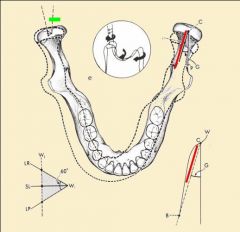![]()
![]()
![]()
Use LEFT and RIGHT arrow keys to navigate between flashcards;
Use UP and DOWN arrow keys to flip the card;
H to show hint;
A reads text to speech;
25 Cards in this Set
- Front
- Back
|
Static vs. Dynamic Relationship between mandible and maxilla
|
STATIC – HINGE AXIS which is less than 20 mm of opening; DYNAMIC – BETWEEN HINGE AND TRANSLATION at over 20mm
|
|
|
Determinants of Occlusion include
|
1) CENTRIC RELATION JAW POSITION – IMPORTANT, 2) Skeletal structure, 3) Anatomy of TMJ, 4) Postural muscle, 5) Vasculature, 6) Neuromuscular, 7) Functional and parafunctional movement, 8) GEOMETRY OF CURVILINEAR (Spherical theory) AND RECTILINEAR (MOST COMMON) MOVEMENT
|
|
|
Hanau’s Quint
|
Formulas that established articulation in the Anaotmic (natural teeth), semi-prosthetic (PD) and Full Prosthetic (Denture)
|
|
|
What are the 3 planes movement/controlling forces?
|
1) Front – Condylar guidance angle (CG angle) and Anterior Guidance Angle (AG angle) may be different, 2) Sagittal – MOST USEFUL, 3) Horizontal – key to understanding laterotrusive movement, Bennet Angle, Wide centric, and cusp position
|
|
|
What are the 2 VERTICAL controlling forces (Mutual Protective Occlusion)?
|
Anterior and Posterior
|
|
|
Describe how (both) vertical forces lead to stable occlusion?
|
POSTERIOR teeth and TMJ stabilize occlusion during maximal intercuspation and ANTERIOR TEETH stabilize excursive movements
|
|
|
What structures are responsible for the POSTERIOR vertical forces?
|
2 TMJs, head of condyle, and TMJ disc
|
|
|
What are the goals of POSTERIOR vertical forces
|
1) Good function, Range of Motion and Stability, 2) Establishing Occlusal Vertical Dimension, 3) Closure Stoppers
|
|
|
Closure Stoppers
|
Posterior teeth and TMJ provide vertical stops
|
|
|
What are some ways vertical controlling forces can be lost (9)?
|
1) Posterior caries, 2) Occlusal wear, 3) Fracture of posterior cusps, 4)Extraction of posterior teeth, 5) Anterior teeth fremitus (vibration), 6) Flaring of teeth, 7) Diastemas, 8) Failure of occlusal stability system, 9) Compressive TMJ disc failure
|
|
|
Overall what makes cusps taller (3)? What makes them shorter?
|
TALLER – Steep TMJ wall and Condylar Guidance (CG) angle, Greater Vertical Overlap, Flatter curve of Spee/Wilson; SHORTER – Greater side shift/Bennett movement, Greater Overjet |
|
|
Relationship between TMJ wall steepness and cusps? Steepness of CG angle and cusps? |

The steeper the wall, the taller the cusps; The steeper the CG angle the taller the cusps
|
|
|
What are the articulating structures of the TMJ and part of the skull are they located?
|
1) Glenoid (mandibular) fossa and articular eminence in the squamous portion of the temporal bone
|
|
|
What is the goal of anterior guidance?
|
Causes teeth to be slightly out of contact when biting in CR (hinge axis) or MI; causes posterior disocclusion
|
|
|
What can go wrong with dentures?
|
1) Collapse of Occlusal vertical dimension, 2) Wear of acrylic denture teeth, 3) Residual ridge resorption (RRR), 4) Collapse of TMJ meniscus, 5) Degenerative Joint Disease (DJD), 6) No CR or no edge to edge contact in MI, 7) Fractured condyle, 8) Class III protruded mandible
|
|
|
Denture Occlusion in anterior vs natural teeth occlusion?
|
Natural occlusion is 45 degrees but dentures are 55 degrees (called COUPLING)
|
|
|
What is overbite vs overjet?
|
1) OVERBITE – Vertical overlap, esp. of maxillary incisor or mandibular incisor; 2) OVERJET – Horizontal projection of the teeth beyond the opposing tooth
|
|
|
What happens with a greater vertical overlap?
|
1) There is less horizontal overlap, 2) There are taller cusps in the posterior, increasing vertical dimension during protrusion - IMPORTANT, 3) There is more protection of the posterior teeth by the anterior teeth
|
|
|
What happens with greater overjet?
|
SHORTER CUSPS since there is less space in the posterior during protrusion – IMPORTANT
|
|
|
What 3 points do the curves of Spee and Wilson touch?
|
1) Condylar surface, 2) Posterior cusp tips, 3) Incisal point
|
|
|
What is tangent to the curve made by Spee and Wilson
|
Plane of Occlusion
|
|
|
What results from variation of the curve and Plane of Occlusion?
|
Variations in cusp height; They are VERTICAL CONTROLS – The flatter the plane (curve) the taller the cusp height can be; IMPORTANT
|
|
|
Significance of horizontal plane
|
The vertical axis passes through this plane and accounts for the greates influence on occlusal anatomy than any other factor
|
|
|
What is Bennett movement? Bennett angle? |

Bennett movement - a bodily side shift of the condyle on the working side in conjunction with rotation (GREEN); Bennett Angle - The angle made by the sagittal plane and a line drawn from the point of origin of the balancing (non-working) condyle to the final position (RED) |
|
|
How does Bennett movement affect cusp height?
|
The greater the side shift, the shorter the cusps will be |

